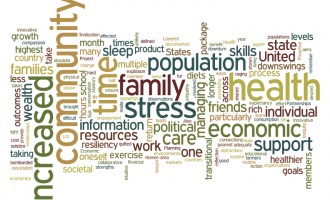We’ve been asking the wrong questions.
We’ve been asking “What’s wrong with you?” when people exhibit self-destructive behaviors, when we need to be asking “What happened to you?”
On the first day of a two-day conference sponsored by the Juneau Suicide Prevention Coalition and Division of Behavioral Health, keynote speakers discussed what they called “adverse childhood experiences” and their impact.
Shirley Pittz, of the Alaska Early Childhood Coordinating Council, and Patrick Sidmore, a planner with the Alaska Mental Health Board, presented research demonstrating the effects of trauma, especially at young ages.
The first three years of children’s lives are important in brain development and establishing stress thresholds, Pittz said. Other phases of life are similarly formative. Trauma and toxic stress in these phases can lead to difficulty calming down and managing stress, and it can affect physical health.
“What data show is that people who have a high number of adverse childhood experiences … have poorer outcomes … when they’re older,” Sidmore said.
The data show a strong correlation between these experiences and suicidal tendencies.
“It’s rate similar to lung cancer and cigarette smoking,” Sidmore said.
Eighty percent of suicide attempts can be linked to these adverse experiences, and Alaska has higher rates of them when compared to other states. The number of adverse childhood experiences isn’t predictive for individuals, but it can tell a lot about populations, making it a valuable at a large scale.
Social worker Amalia Monreal spoke about trauma beyond what an individual experiences. She spoke about intergenerational trauma, something found in Alaska Native and American Indian populations whose histories include layers of oppression and suppression, boarding schools and internments. On top of that are anxiety, guilt, substance abuse and more.
“The ones who suffer the most are the children, because they inherit our grief,” Monreal said. “If we don’t talk about it, heal, we are bound to pass it on.”
She invited a client, Patricia Graham, to the stage. Graham shared a family chart she created in a group session with Monreal. It was dotted with circles and squares, each representing a member of her family. Many were filled with colored stripes representing different traumas and harmful behaviors. She shared personal recollections of her own abuse and how, from a young age, she wished to die.
She shared how these traumas had manifested as substance abuse problems, suicidal thoughts and self-harm. The hardest thing was losing her children when she couldn’t take care of them.
What saved her from a completed suicide attempt, she said, was seeking professional help and having people who cared about her and fought for her when she couldn’t fight for herself.
The morning was heavy with harrowing statistics and heart-wrenching accounts, but the afternoon was filled with suggestions to address suicide and prevention by dealing with its underlying causes.
“Trauma-informed care,” applying knowledge of past trauma in treatment, can happen at different levels, though Sidmore pointed out that it often stops short.
He visited a substance abuse treatment center in Ketchikan where people receive treatment for substance abuse. When they are released, there’s no housing for them.
“They’re at a great treatment center, doing their job, but we haven’t extended trauma-informed systems beyond the walls,” Sidmore said. “Guess what the outcomes are like. … Not good.”
Another lesson was having everyone trained to deal with trauma — including the receptionist and the janitorial staff — so there’s a feeling of safety throughout.
There was a strong focus on how to reach out to kids, how to assure them there is someone looking out for them and that they feel supported in their community. Not feeling supported has a strong correlation with suicidal attempts or thoughts much like depressive behaviors do — but Pittz reminded attendees that resilience can be developed at any age.
“Learning to cope with manageable threats is critical for the development of resilience, and you can do this at any time in your life,” Pittz said.
Risk factors can be hard to control, but protective factors can counter them. Some options listed were peer or adult supports, dancing, drumming, yoga or breathing exercises to “calm the lower brain and allow the higher brain to kick in.”
There are also programmatic approaches, like Strengthening Families in Alaska, Pittz recommended, or Parents as Teachers for early families, as recommended by Sidmore.
And it can be done at a community or societal level as well.
“Countries that support early bonding and attachments … have the lowest rates of child abuse and neglect,” Pittz said, referencing Canada’s year of parental leave, for example.
With insight to a strong cause of suicide — though not the only potential cause — there are ways to fight it, and Pittz said “it’s not rocket science.”


